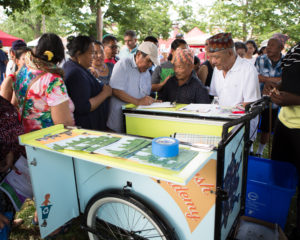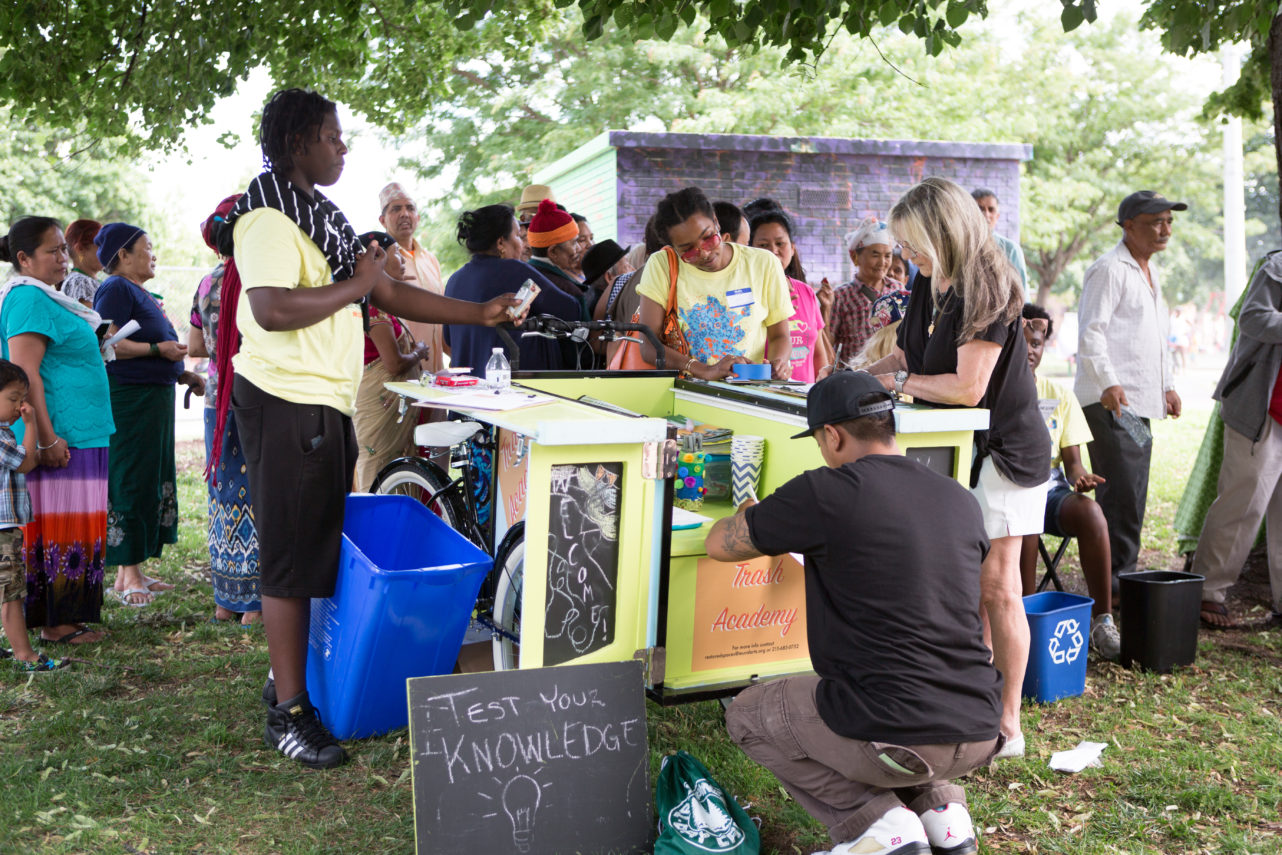Whether it’s roadways dotted with cigarette butts, household trash left next to municipal cans, businesses setting trash out days before it’s due for pick-up, or dumping developers, Philly’s struggles with trash are everywhere you look.
“If everyone understood how to get people not to litter, we wouldn’t be here.”
This comment from an attendee of March’s Litter Convening meet-up, an ongoing forum on trash in Philly helmed by Keep Philadelphia Beautiful (KPB), summed up the challenge well.
KPB director Michelle Feldman led the crowded meeting on the top floor of the Municipal Services Building, featuring speakers from Mural Arts, Fishtown Neighbors Association, and North Broad Renaissance, plus a presentation from the director of the City of Philadelphia’s Zero Waste and Litter Cabinet, Nic Esposito.
A dynamic coalition of city activists are fighting back with new outreach, innovating programming, and accessible tools to meet Philly’s litter-free goal.
Shari Hersh and Ciara Williams, who work on the Trash Academy at Mural Arts (under the Restored Spaces Initiative), spoke about this “collaboratory” to educate locals on trash.
The program is based out of South Philadelphia High School, though it includes students from across the city. After a study showed that nearby residents didn’t know the resources available to them to deal with trash and comply with city policies, the Trash Academy developed a “rights and responsibilities” flyer in five different languages.

Among many other programs, Trash Academy also has a Trashmobile: a bike repurposed into a roving educational vehicle distributing recycling bins and offering surveys and games. Williams said the program’s citywide roster of educational games includes “Name That Trash,” which teaches about different types of trash, and how we transport and dispose of them.
“Our methodology is based on how activists work,” Hersh said. They note the most pressing quality-of-life issues on the ground, and work from there. Anyone can invite Trash Academy representatives to a community event.
Next, attendees heard from Monica King, chair of the Beautification Committee at Fishtown Neighbors Association (FNA), about its Feed the Fish program. This mashup of art and trash infrastructure gives new trash cans whimsical, colorful fish-head toppers that increase the visibility of the receptacles and encourage people to use them.
Fishtown currently has 26 fish cans, King said, and the success of their program is making other registered community organizations (RCOs) take notice. She described the Feed the Fish process.
First, a local artist gets a stipend to design the can’s unique topper, and then a vendor fabricates it. FNA locates an “adopting partner” to manage emptying the new can (could be a resident, business, or school). The city provides a new wire can, and FNA tops it with an artsy fish head and installs it.
King says illegal dumping still happens (a common problem at trash cans throughout the city), but signs noting a $150 fine for household dumping deter this. They’ve streamlined their application process for adopting partners and set clear expectations for them (King says many businesses are eager to maintain a fish can, which turn garbage bins into quirky art pieces). Feed the Fish mostly serves commercial corridors now, but King hopes to expand into residential locations in future.
Trina Benjamin spoke next. Her company, TWB Cleaning Contractors, operates commercial corridor cleaning for the North Broad Renaissance special service district (SSD). The corridor she manages (almost three miles) stretches from City Hall to Germantown Avenue, and, she said, sees 30,000 vehicles a day, besides mass transit on the Broad Street Line and the number 4 and 16 buses. That means lots of people, and lots of trash.
On average, they collect 1,500-2,000 pounds of trash per week. Cigarette butts are the number-one litter item, Benjamin said. Businesses that put their trash in the street days ahead of scheduled pick-up are also a problem. She said that a consistent program of notices to businesses that are close to being reported for the violation via the SSD (which is a member of the City’s 311 liaison program) helps reduce the problem—in addition to thank-you notes to compliant businesses.
“People want a community that feels safe,” not a heavily littered one, she said. And just being present as a familiar face, consistent trash pick-up, deters litterers. “A lot if it is just footwork,” she added of her combination of education, encouragement and enforcement. “You got to go out and get the pulse of the people.”
Finally, Esposito gave an update on the City’s anti-litter efforts. Fines, arrests and prosecutions are up for dumping offenders, he said (with most of those convicted sentenced to community service, rather than jail time). And legislation for vehicle seizure (as in the case of developers who illegally dump their debris) is underway for littering from a vehicle, he added.
The City is also combating the “bandit sign” epidemic, in which everyone from predatory home-buyers to club promoters plaster surfaces and poles with unapproved signage. Esposito cited a long line of criminality for some of these offenders, whose advertising exploits vulnerable people, and even puts children in harm’s way by hiring them to put up the signs. Part of the solution is better communication (Esposito said club owners often claim to be “shocked” that posting their signs on telephone poles is illegal): “We can’t arrest our way out of the problem.” In June, there’ll be a city-wide bandit sign round-up (here’s more info).
The City also has released its new Litter Index, an interactive city-wide map that Esposito called the “most comprehensive data on litter the city has ever collected,” based on 42,000 data points (and growing). Users can enter their address and see a litter index for their individual block and neighborhood.
The City’s litter index goes from “1” to “4,” Esposito explained: “1” is no litter; “2” is litter one person can clean up; “3” is litter a team of people can tackle; and “4” is a site requiring heavy machinery for clean-up. He encourages everyone in the city to use the map, which you can access anytime at CleanPHL.org. Along with data for your neighborhood, the Litter Index also offers a customized set of resources by location: listing trash days, block captains (or how you can become a block captain), sanitation centers, nearby Friends groups, commercial corridor/RCO cleaning initiatives, and even a contact point for water management.
That means Litter Index users aren’t just accessing data; they’re getting the tools to make a difference in their neighborhood.
“This conversation needed to happen,” Esposito said.

